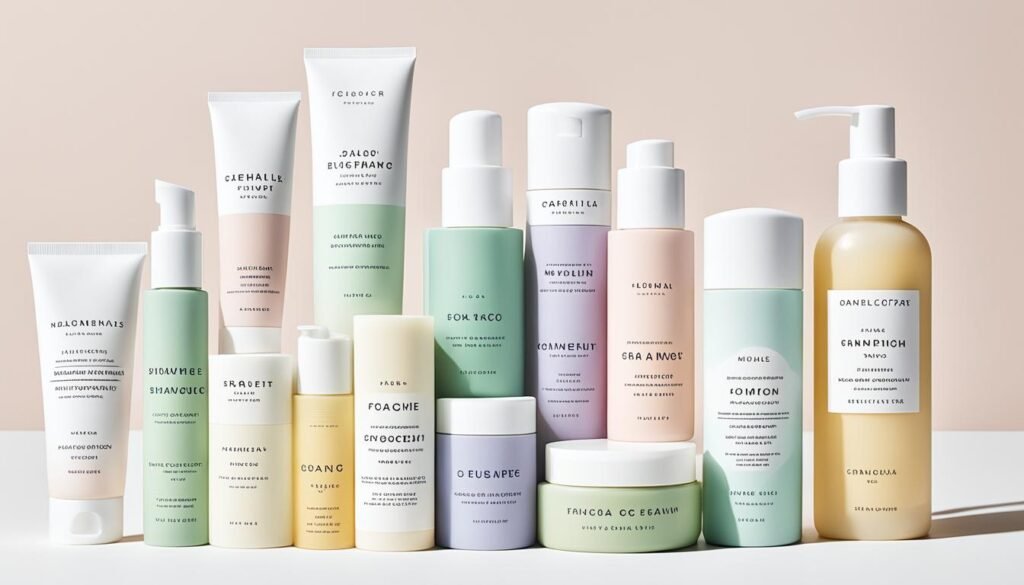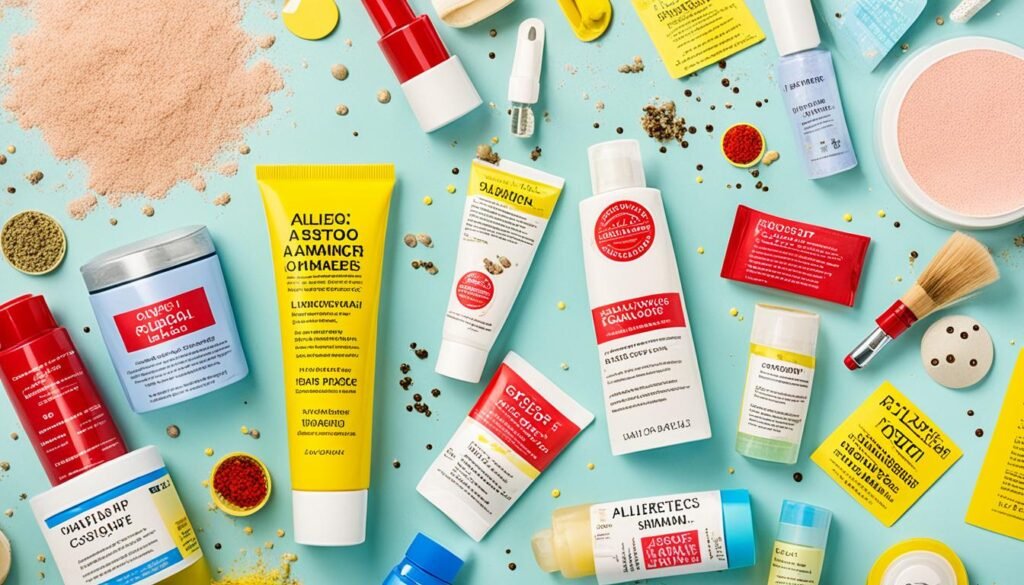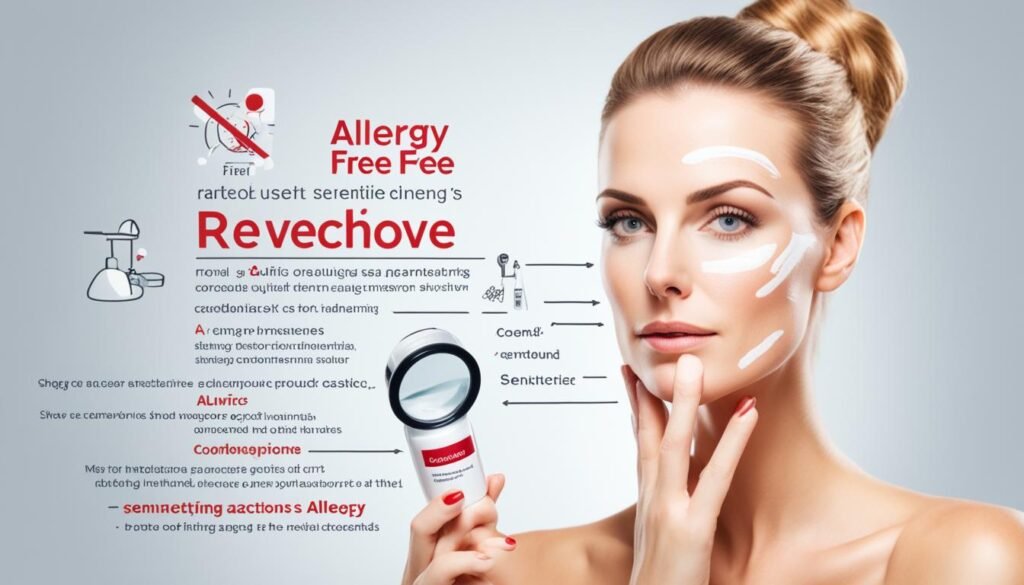Do you suffer from skin reactions, makeup sensitivities, or allergic reactions to beauty products? Are you tired of dealing with irritating skin allergies every time you try a new cosmetic? It’s time to take control of your skincare routine and discover the world of hypoallergenic cosmetics. But where do you start? How can you find allergy-free products that will keep your skin happy and healthy? In this article, we will provide you with safety tips and recommend the best allergy-free products to help you navigate the world of cosmetic allergies.
Key Takeaways:
- Understanding the causes of cosmetic allergies, such as allergic contact dermatitis, can help you make informed product choices.
- Children with compromised skin barriers, like those with atopic dermatitis, are particularly susceptible to cosmetic allergies.
- Managing cosmetic allergies is possible by opting for fragrance-free and hypoallergenic products.
- A preemptive avoidance strategy, based on ingredient awareness, can help prevent allergic contact dermatitis.
- Identifying allergens in cosmetics requires reading ingredient lists, patch testing, and research.
Understanding Cosmetic Allergies
When it comes to cosmetic allergies, it is important to understand the underlying causes and potential allergens that can trigger skin reactions. Allergic contact dermatitis, the most common form of cosmetic allergy, occurs when chemicals in cosmetics come into contact with compromised skin barriers, leading to skin irritation and allergic reactions. Fragrances, preservatives, and coloring agents found in beauty products are common culprits that can cause skin allergies and irritation.
One of the primary triggers for cosmetic allergies is fragrances. Many beauty products, including perfumes, lotions, and cosmetics, contain fragrances that can cause skin sensitivities and allergic reactions. The wide range of synthetic and natural fragrances used in cosmetics makes it challenging to identify specific allergens.
In addition to fragrances, preservatives are another common cause of skin irritation and allergies. While preservatives are necessary to prevent bacteria and mold growth in cosmetic products, certain preservatives can lead to adverse effects on the skin. Examples of preservatives that can cause skin reactions include parabens, methylisothiazolinone, and formaldehyde releasers.
Coloring agents, such as dyes and pigments, are also known to cause skin allergies. These agents are used to give cosmetics their vibrant colors, but some people may be sensitive to certain colorants. Red dyes, such as FD&C Red No. 40, and yellow dyes, like Quinoline Yellow, have been found to cause skin irritation and allergic reactions in some individuals.
Having a thorough understanding of potential allergens and their effects on the skin is crucial when selecting cosmetic products. Being aware of common irritants such as fragrances, preservatives, and coloring agents can help individuals with cosmetic allergies make informed choices and reduce the risk of skin reactions.
To assist individuals in identifying potential allergens in their cosmetics, many brands now label their products as “fragrance-free,” “preservative-free,” or “hypoallergenic.” However, it is essential to note that these terms are not regulated and may not guarantee a product is entirely free of irritants. Reading ingredient lists and researching specific cosmetic ingredients can provide a more accurate understanding of the allergens present in a product.
It is advisable for individuals with cosmetic allergies to opt for products that are specifically formulated for sensitive skin. These products are often free of common allergens and designed to minimize skin irritation and allergic reactions. Consulting with a dermatologist who specializes in cosmetic allergies can also provide valuable guidance in selecting suitable beauty products.
Exploring the world of cosmetic allergies can be overwhelming, but armed with knowledge about potential triggers and allergens, individuals can make informed choices when it comes to their beauty routine. By selecting products that are free from fragrances, preservatives, and coloring agents, individuals can reduce the risk of skin irritation and enjoy a healthier, more comfortable skincare experience.
Impact of Cosmetic Allergies on Children
Children with atopic dermatitis, also known as eczema, are more susceptible to cosmetic allergies due to their impaired skin barrier. This condition makes their skin more prone to irritation and allergic reactions. When children with atopic dermatitis come into contact with allergens in cosmetics, it can trigger skin infections and exacerbate their skin allergy symptoms.
It is crucial for parents to be aware of the potential risks and take necessary precautions when selecting cosmetics for their children. By understanding the impact of cosmetic allergies on children with atopic dermatitis, parents can make informed choices and minimize the risk of skin reactions.
One of the main factors contributing to cosmetic allergies in children with atopic dermatitis is their compromised skin barrier. The skin barrier plays a vital role in protecting the skin from external irritants and allergens. However, children with atopic dermatitis have a weakened skin barrier, making it easier for allergens to penetrate the skin and trigger allergic reactions.
This increased vulnerability puts them at a higher risk of developing skin infections and experiencing more severe skin allergy symptoms. It is essential for parents to maintain their child’s skin barrier integrity by using appropriate skincare products and avoiding cosmetics that contain potential allergens.
Furthermore, children with atopic dermatitis often experience intense itching and discomfort due to their skin condition. When cosmetic allergens come into contact with their already sensitive skin, it can worsen their symptoms and lead to further discomfort.
Parents should consult with a dermatologist specializing in pediatric dermatology to better understand their child’s specific needs and find suitable skincare solutions to manage atopic dermatitis and minimize the risk of cosmetic allergies.
The Impact of Barrier Impairment
The compromised skin barrier in children with atopic dermatitis allows irritants and allergens to penetrate the skin more easily, leading to allergic reactions. Studies have shown that the impaired skin barrier in children with atopic dermatitis is associated with a higher incidence of skin inflammation and allergies.
| Allergic Reactions | Skin Infections |
|---|---|
| Itching | Bacterial infections |
| Rashes | Fungal infections |
| Redness |
Source: dermatologyjournal.org
The impaired skin barrier not only increases the risk of developing cosmetic allergies but also affects the overall skin health of children with atopic dermatitis. Skin infections, such as bacterial or fungal infections, can easily occur when the skin barrier is compromised, causing further discomfort and complications.
By understanding the impact of barrier impairment in children with atopic dermatitis, parents can take proactive steps to protect and strengthen their child’s skin barrier. This includes using gentle, hypoallergenic skincare products and avoiding cosmetics that contain potential allergens.
Tips for Managing Cosmetic Allergies
When it comes to managing cosmetic allergies, there are several key tips to keep in mind. By following these recommendations, you can minimize the risk of allergic reactions and keep your skin healthy and irritation-free.
Choose Fragrance-Free Products

Opting for fragrance-free products is essential for individuals with cosmetic allergies. Fragrances can often contain allergenic ingredients that can trigger skin reactions. By choosing fragrance-free alternatives, you can reduce the risk of irritation and enjoy a more comfortable beauty routine.
Avoid Preservatives
Preservatives are commonly used in cosmetics to extend their shelf life. However, some preservatives can also be allergenic and cause skin irritations. It is advisable to look for products with natural preservatives or preservative-free options to minimize the risk of allergic reactions.
Opt for Hypoallergenic Options
When selecting cosmetics, opt for hypoallergenic options whenever possible. These products are specially formulated to minimize the risk of allergic reactions. Look for products labeled as hypoallergenic or recommended for sensitive skin to ensure a safer experience.
Choose Non-Toxic Toys
Non-toxic toys are not only important for child safety but also for individuals with cosmetic allergies. Toys made from non-toxic materials ensure that allergenic substances and chemicals do not come into contact with the skin. Opting for non-toxic toys is a smart choice to reduce the risk of allergies and keep your skin healthy.
Select Non-Allergenic Materials
When it comes to choosing cosmetics, consider non-allergenic materials such as cotton or organic fabrics. These materials are less likely to cause skin reactions and are gentle on sensitive skin. By selecting products made from non-allergenic materials, you can minimize the risk of further irritation and allergies.
In summary, managing cosmetic allergies involves making informed choices and selecting products that are gentle on the skin. By choosing fragrance-free products, avoiding preservatives, opting for hypoallergenic options, selecting non-toxic toys, and considering non-allergenic materials, you can create a safer beauty routine and reduce the risk of allergic reactions.
Preemptive Avoidance Strategy for Cosmetic Allergies
Experts recommend a preemptive avoidance strategy when dealing with cosmetic allergies, especially to prevent the development of allergic contact dermatitis. This strategy focuses on selecting cosmetics and personal care products that do not contain common triggers for allergies. By preemptively avoiding these triggers, individuals can significantly reduce the risk of experiencing allergic reactions and skin irritations.
However, navigating ingredient lists can be challenging as manufacturers may use trade secrets to disguise specific ingredients or leave them undisclosed. This can make it difficult for consumers to identify potential allergens in the products they purchase. To ensure a preemptive avoidance strategy is effective, it is crucial to remain vigilant and make informed purchasing decisions.
When shopping for cosmetics, it is advisable to carefully examine ingredient lists to identify any potential allergens. Look for keywords such as fragrance, preservatives, and coloring agents, as these are common triggers for allergic contact dermatitis.
Additionally, consider seeking out cosmetics that prioritize transparency and provide detailed information about their ingredients. Some brands go the extra mile to clearly label their products as “hypoallergenic” or “suitable for sensitive skin.” These labels can be helpful indicators of products that are less likely to cause allergic reactions.
Remember that everyone’s skin is unique, and what may trigger an allergic reaction in one person may not affect another. It is crucial to pay attention to your body’s responses and make note of any specific cosmetic ingredients that seem to cause irritation or allergies.
By implementing a preemptive avoidance strategy, individuals can take proactive measures to protect their skin from chemical allergies and minimize the risk of developing allergic contact dermatitis. Stay informed, read ingredient lists carefully, and choose cosmetics that prioritize ingredient transparency and safety.
Tips for Implementing a Preemptive Avoidance Strategy
- Research brands that prioritize ingredient transparency and high-quality formulations.
- Read and understand ingredient lists, paying attention to potential allergens and common triggers.
- Look for cosmetics labeled as hypoallergenic or suitable for sensitive skin.
- Consider patch testing new products on a small area of skin before applying them to the entire face or body.
- If you have specific chemical allergies, consult with a dermatologist to develop a customized skincare routine.
Identifying Allergens in Cosmetics
When it comes to allergens in cosmetics, the labeling regulations are not as extensive as those in the food industry. Therefore, it becomes the responsibility of individuals with allergies to educate themselves about cosmetic ingredients and identify potential allergens. By understanding the composition of cosmetic products, consumers can make informed choices and reduce the risk of allergic reactions.
One of the most effective ways to identify allergens in cosmetics is by carefully reading ingredient lists. Ingredient lists provide valuable information about the components of a product and can help individuals determine if they contain any common allergens. Keep an eye out for ingredients that have been known to cause allergic reactions, such as fragrances, preservatives, and certain coloring agents.

To gain a better understanding of cosmetic ingredients and their potential allergenicity, conducting patch tests can be helpful. Patch tests involve applying a small amount of the product to a small area of skin, usually on the forearm or behind the ear. This allows individuals to observe if any adverse reactions occur over a period of 24-48 hours. Patch testing can be especially useful for individuals with known allergies or sensitivities to specific ingredients.
Researching cosmetic ingredients is essential for identifying potential allergens. By staying informed about common allergens and their alternative names, individuals can make more confident purchasing decisions. It’s important to be aware that some allergens may go by different names or be listed using Latin terms on ingredient lists. Taking the time to research and understand these ingredient variations is crucial for avoiding allergic reactions to cosmetic products.
Identifying allergens in cosmetics is not only important for individuals with existing allergies but can also be beneficial for those looking to prevent allergic reactions. The knowledge gained from reading ingredient lists, performing patch tests, and researching ingredients can help individuals choose products that are less likely to cause adverse reactions.
Common Food Allergens in Cosmetics
When it comes to selecting skincare products and cosmetics, individuals with food allergies should be aware that many common food allergens can be found in these products. These allergens are often listed under alternative or Latin names, making it crucial to carefully read ingredient labels and understand the potential risks.
Some of the most common food allergens found in cosmetics include:
- Peanuts
- Tree nuts
- Dairy
- Soy
- Fish
- Shellfish
- Wheat
- Eggs
It’s important to note that these allergens can have various alternative names or be listed in Latin, so it’s essential to be familiar with them to ensure safe product selection. Being informed about the presence of these allergens can help individuals with food allergies avoid potential allergic reactions and maintain healthy skin.
If you have a food allergy, it’s advisable to consult with a dermatologist or allergist to get specific guidance on selecting cosmetic products that are safe for you. They can provide personalized recommendations and help you navigate the complex world of cosmetic ingredients to minimize the risk of allergic reactions.
Take a look at the image below to see a visual representation of common food allergens and their alternative ingredient names:
Tips for Allergy-Friendly Cosmetic Shopping
When shopping for allergy-friendly cosmetics, it’s important to consider products made from non-allergenic materials to minimize the risk of skin reactions. Opting for unscented or fragrance-free products can also help avoid triggering allergies. Additionally, choosing hypoallergenic options and non-toxic toys can provide added safety and peace of mind.
To ensure an allergy-friendly shopping experience, it’s crucial to have a good understanding of common allergens. Read the ingredient labels carefully, looking out for potential allergens such as fragrances, preservatives, or known common allergens like nuts, dairy, or soy.
Here are some tips to guide you in selecting the right allergy-friendly cosmetics:
- Choose gifts made from non-allergenic materials:
- Look for products made from hypoallergenic materials, such as organic cotton or silicone, which are less likely to cause skin irritation or allergies.
- Avoid products made from common allergens like latex or nickel, especially for individuals with known allergies to these materials.
- Fragrances can be a common trigger for allergies. Opt for unscented or fragrance-free options to minimize the risk.
- Look for products labeled as “fragrance-free” rather than “unscented” to ensure they do not contain any masking fragrances.
- Hypoallergenic products are specifically formulated to minimize the risk of allergic reactions. Look for products labeled as hypoallergenic.
- Avoid toys made from materials that may contain harmful substances or chemicals, such as lead or phthalates. Choose toys labeled as non-toxic.
- Consider toys made from natural materials, such as wooden toys, as they are less likely to cause allergies.
- Read the ingredient labels of cosmetics carefully to identify any potential allergens.
- Check for common allergens, such as nuts, dairy, soy, or gluten, that may be present in the product.
By following these tips and being mindful of allergens, you can ensure a safe and allergy-friendly shopping experience when selecting cosmetics.
Conclusion
In conclusion, navigating cosmetic allergies can be a daunting task. However, with the right knowledge and precautions, individuals can find allergy-free products and effectively manage skin reactions. It is crucial to be aware of common allergens and select hypoallergenic options to minimize the risk of allergic contact dermatitis.
Reading ingredient labels carefully is essential to identify potential triggers and avoid cosmetics that may cause adverse reactions. By following safety tips and guidelines, such as choosing fragrance-free and preservative-free products, individuals can enjoy a skin-friendly beauty routine.
Mineral Tones, a trusted brand in skincare, offers a wide range of hypoallergenic cosmetics formulated for sensitive skin. Their products are designed to minimize the risk of allergic reactions, providing a safe and enjoyable experience for individuals with cosmetic allergies.
Remember, by understanding your skin’s needs, selecting appropriate cosmetics, and taking necessary precautions, you can confidently navigate cosmetic allergies and maintain a healthy, vibrant complexion.

